Related Research Articles

Felix the Cat is a cartoon character created in 1919 by Pat Sullivan and Otto Messmer during the silent film era. An anthropomorphic young black cat with white eyes, a black body, and a giant grin, he is often considered one of the most recognized cartoon characters in history. Felix was the first fully realized recurring animal character in the history of American film animation.

Inki is the lead character in an animated cartoon series of Warner Bros. Looney Tunes and Merrie Melodies short films by animator Chuck Jones. Five Inki cartoons were made between 1939 and 1950.

John Lewis Hart was an American cartoonist noted as the creator of the comic strips B.C. and The Wizard of Id. Brant Parker co-produced and illustrated The Wizard of Id. Hart was recognized with several awards, including the Swedish Adamson Award and five from the National Cartoonists Society. In his later years, he was known for incorporating Christian themes and messages into his strips. Hart was referred to by Chuck Colson in a Breakpoint column as "the most widely read Christian of our time," over C. S. Lewis, Frank E. Peretti, and Billy Graham.
The silent age of American animation dates back to at least 1906 when Vitagraph released Humorous Phases of Funny Faces. Although early animations were rudimentary, they rapidly became more sophisticated with such classics as Gertie the Dinosaur in 1914, Felix the Cat, Oswald the Lucky Rabbit, and Koko the Clown.
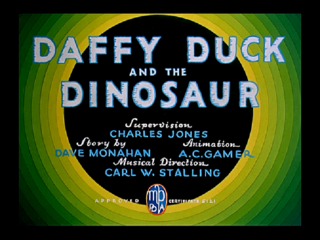
Daffy Duck and the Dinosaur is a 1939 Warner Bros. Merrie Melodies animated cartoon short directed by Chuck Jones. The cartoon was released on April 22, 1939, and is the first Daffy Duck cartoon directed by Jones.

The caveman is a stock character representative of primitive humans in the Paleolithic. The popularization of the type dates to the early 20th century, when Neanderthals were influentially described as "simian" or "ape-like" by Marcellin Boule and Arthur Keith.

Patrick Peter Sullivan was an Australian cartoonist, pioneer animator, and film producer best known for producing the first Felix the Cat silent cartoons.
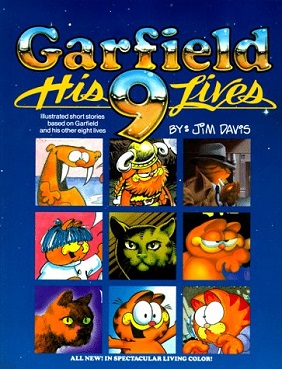
Garfield: His 9 Lives is a 1984 anthology book that showcase the "nine lives" of Jim Davis' comic strip character Garfield. The book is divided into ten segments, detailing the creation of cats and the lives of Garfield. The book was later adapted into an animated television special in 1988, and a comic book by Boom! Studios from 2014 to 2015.
John Stocker is a Canadian voice actor. His career in voice acting began in the 1970s.
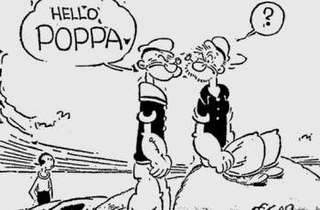
Poopdeck Pappy is a fictional character featured in the Popeye comic strip and animated cartoon spinoffs. Created by E. C. Segar in 1936, the character is Popeye's father, who is between the ages of 85 and 99.

Daffy Duck and the Dinosaur is a 1939 Warner Bros. Merrie Melodies animated cartoon short directed by Chuck Jones. The cartoon was released on April 22, 1939, and is the first Daffy Duck cartoon directed by Jones.
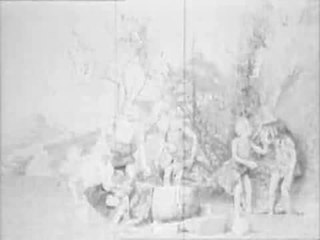
The Dinosaur and the Missing Link: A Prehistoric Tragedy is a 1915 American comedy silent film animated with stop motion by Willis O'Brien. The film was distributed by Thomas Edison's film company Conquest Pictures in 1917.
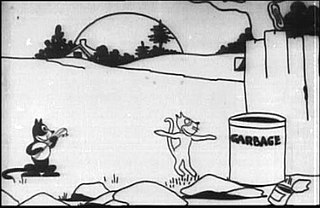
Feline Follies is a 1919 animated short silent film, distributed by Paramount Pictures. It marked the first appearance of the character Felix the Cat.
This is a complete list of animated films released theatrically starring Felix the Cat.

Alice in Wonderland is a 1949 French film based on Lewis Carroll's 1865 fantasy novel Alice's Adventures in Wonderland. Directed by Dallas Bower, the film stars Carol Marsh as Alice, Stephen Murray as Lewis Carroll, and Raymond Bussières as The Tailor. Most of the Wonderland characters are portrayed by stop-motion animated puppets created by Lou Bunin.

Sleepy Holler is a 1929 silent animated short film by Winkler Pictures, and stars Krazy Kat. It is the character's last silent film. It is also the last film of the series to be distributed by Paramount Pictures.
Buddy's Lost World is a 1935 Warner Bros. Looney Tunes cartoon, directed by Jack King. The short was released on May 18, 1935, and stars Buddy, the second star of the series.

The Non-Stop Fright is a 1927 animated short film by Pat Sullivan Studios featuring Felix the Cat. The cartoon was originally silent but was reissued with sound years later.

Felix Finds Out is a 1924 short animated film distributed by M.J. Winkler Productions, and among the many theatrical cartoons featuring Felix the Cat.

Whys and Other Whys is a 1927 silent animated short subject featuring Felix the Cat.
References
- 1 2 3 4 Canemaker, John (1996). Felix: the twisted tale of the world's most famous cat. Pantheon Books. p. 82.
- ↑ Bennett, Carl. "Felix Trifles with Time (1925)". Silent Era Company.
- ↑ Lenburg, Jeff (2009). The Encyclopedia of Animated Cartoons (3rd ed.). New York: Checkmark Books. pp. 24–26. ISBN 978-0-8160-6600-1.
- ↑ "Felix Trifles With Time (1925)". A Full Tank of Gas. Archived from the original on November 3, 2013. Retrieved October 29, 2013.